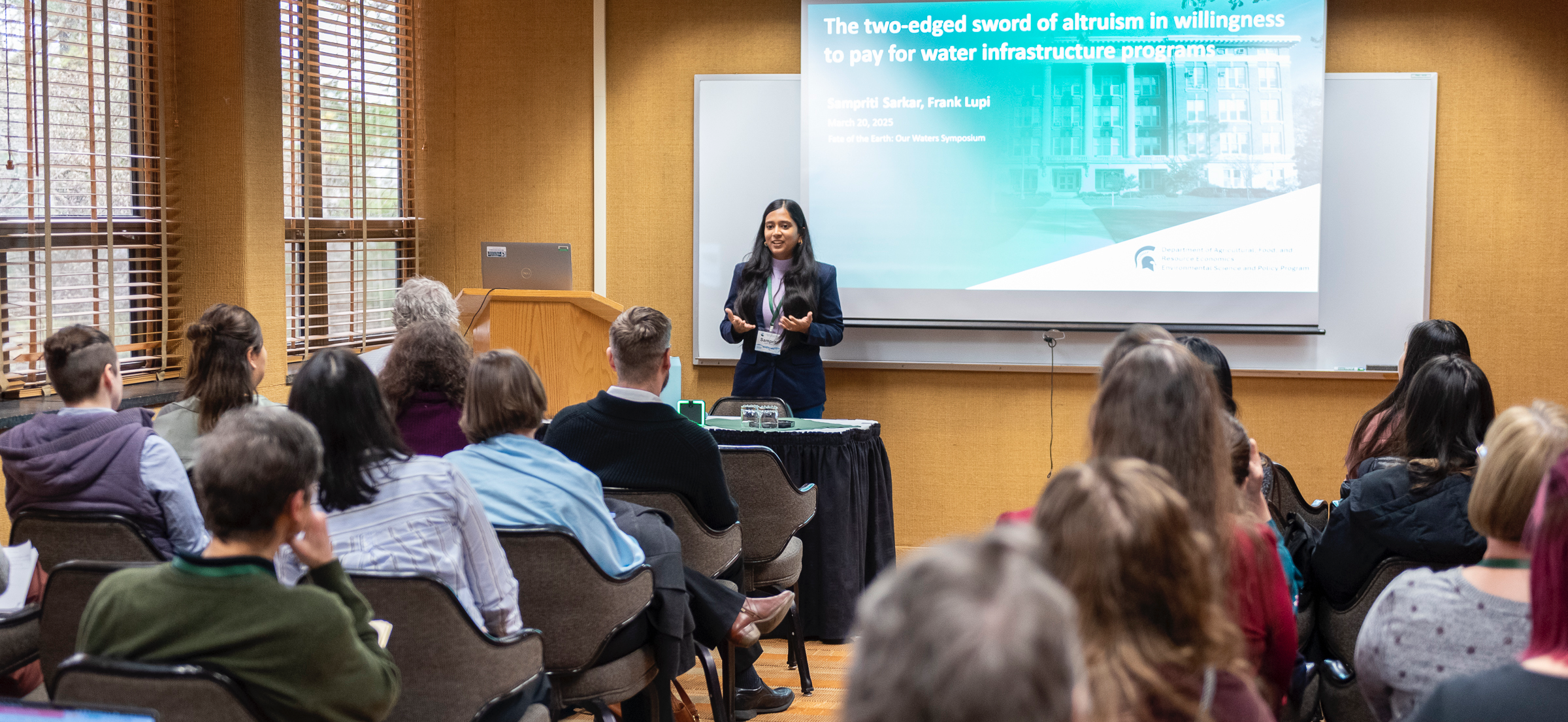
MSU PhD candidate Sampriti Sarkar delivers her oral presentation: The two-edged sword of altruism in willingness to pay for water infrastructure and affordability programs. PHOTO by Jackie Hawthorne.
Published March 30, 2025
The Fate of the Earth: Our Waters Symposium, hosted by MSU’s Environmental Science and Policy Program, WaterCube NRT and the MSU Water Alliance, took place at the Kellogg Hotel and Conference Center on March 20-21, 2025. The event brought together scientists, students and community members to discuss sustainability, address environmental challenges, and showcase MSU’s water-focused collaborations.
Couldn’t make it? Here’s what happened:
Key Moments
MSU President Kevin M. Guskiewicz set the tone for an engaging and dynamic event, kicking off day one with inspiring opening remarks on the university’s commitment to innovation and water research. To capture the moment, he concluded his speech with a signature stage selfie!
Panels
Building Resilience along Michigan’s Great Lakes Shores: Partnerships, Data, and Policies
This panel addressed the challenges of fluctuating Great Lakes water levels, coastal erosion and storms, emphasizing the need for more flexible management strategies. Ronda Wuychek discussed the importance of community resilience and policy-driven solutions, while Ethan Theuerkauf highlighted the role of data and technology in understanding shoreline dynamics. David Bunte shared local efforts to regulate shoreline development and discussed the balance between property rights and environmental sustainability. Richard Norton talked about the role of local governance in coastal management, and the panel explored insurance challenges and how AI-driven data analysis could improve decision-making.
An academia-industry-government partnership that monitors and predicts outbreaks in Tri-County Detroit area since 2017
This panel discussed a partnership between academia, industry and government that uses wastewater surveillance to monitor outbreaks in Detroit’s Tri-County Area. MSU Professor Irene Xagoraraki explained the use of wastewater samples to detect pathogens like SARS-CoV-2, while John Norton emphasized the effectiveness of the collaboration and funding from the Great Lakes Water Authority. Michael Swain discussed the practical benefits of the academia-industry-government approach for public health, Anna Mehrotra provided a national perspective on wastewater surveillance, noting a significant increase in the number of sites using this method for public health since 2020, and Russell Faust highlighted the need for continuous improvements to surveillance methods.
Insights from funders, stakeholders, and decision-makers on priorities for water science, engagement, and education
This panel discussed the importance of water, particularly the Great Lakes, and the need for new partnerships and interdisciplinary collaboration. Claire Chase highlighted global water access challenges, noting that billions lack access to safe drinking water and sanitation. Jennifer Boehme emphasized the role of the Great Lakes Observing System (GLOS) in advancing water management through data and technology. Samuel Passmore and Cyndi Roper focused on policy changes, the need for a national consensus on clean water, and the importance of public-private collaboration.
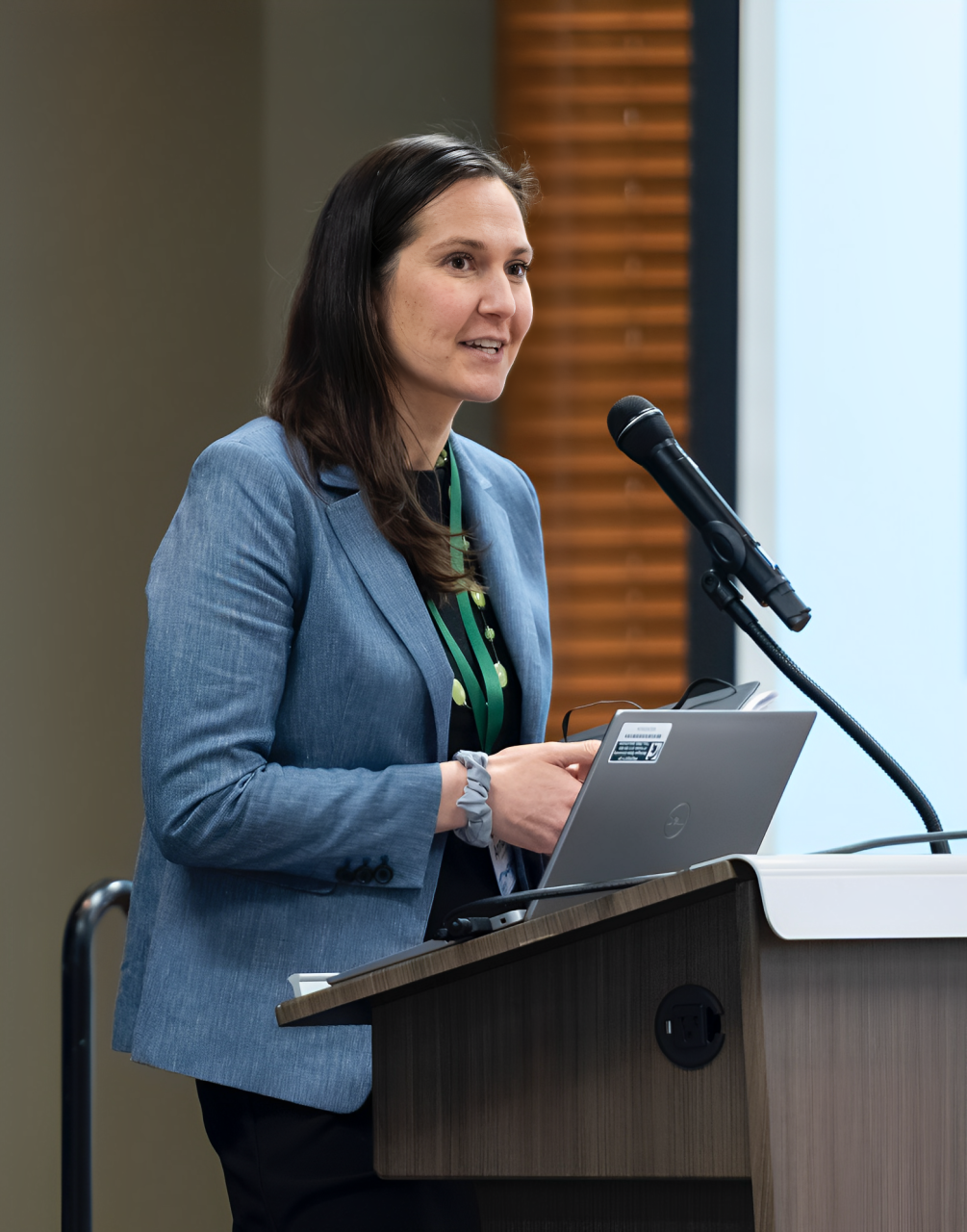
Dr. Annalise Blum delivers keynote speech at Fate of the Earth Symposium.
Standout Speakers
Keynote speaker Dr. Annalise Blum discussed her journey from academia to government, emphasizing the importance of non-stationarity and multidisciplinary approaches to tackling global water security. Blum explained her role at the U.S. Department of the Interior and the U.S. Geological Survey (USGS), recounting their efforts to monitor water resources and predict future climate changes. She discussed working on key projects like the USGS Science Collaboration Portal for the Colorado River Basin, and the Grand Ethiopian Renaissance Dam, highlighting the need for international cooperation in water management. Blum also addressed increasing global water conflicts and the importance of translating scientific research into actionable information for decision-makers.
Lansing area poets Ruelaine Stokes and Zoë Johnson captivated the audience with their water-related works
Lansing’s Poet Laureate, Ruelaine Stokes presented three poems at the Fate of the Earth Symposium, each with a focus on water. “Yellowstone River—Livingston, Montana” perfectly illustrates the special place this body of water holds in her heart; “Owashtanong” is about the Grand River in Michigan and captures both its force and its history; and “We Are Water” highlights the impressive connection between humans and water.
“Water is all around us; it’s so much a part of our lives,” Stokes said. “The connection between our body, our blood, our arteries, our capillaries, and how much of that is like river systems—rivers and streams. The more you start thinking about water, the more you see that we are connected to water in a very vital, necessary, immediate way.”
Zoë Johnson, another Lansing area poet who read their work “Distance, Social and Temporal; or the 2020s on Indian Time” at the symposium, also emphasized the interconnectedness of all living things, past and present, through the natural world. The river in Johnson’s poem symbolizes continuity, literally holding the imprints of beings who have come before.
Discussing the relationship between science and art, Johnson stated that while academic disciplines are often segregated, collaboration in both real-life and academic settings require interdisciplinary approaches. They argue that science and art can complement one another, particularly when addressing complex issues like public health and ecology.
“I really do think that the arts are just another language for talking about the same things,” Johnson said. “And they can help us look at things and talk about things from a different perspective that isn’t opposite—it’s complementary.”
Vibrant Moments
Breakout Sessions
Eco Hub
The Eco Hub discussed the challenges of resilience and water use in coastal ecosystems, particularly how changes to infrastructure affect aquatic systems. They talked about the need to strengthen partnerships between MSU, EGLE and DNR to improve management of both coastal and inland waters. There was a lot of excitement around creating student projects, internships, and classes to support this research and make an impact on water management.
OneHealth Hub
The OneHealth Hub got creative and put together a short video during their breakout session to showcase the power of collaboration and highlight a water-related issue. The goal was to break down barriers between different groups, showcasing how working together can lead to real solutions.
FEW Hub
The FEW Hub focused on how we can make food, energy and water systems more sustainable, especially in rural and small communities. They talked about setting up a project dashboard to tackle the challenges of circular economies and how to get groups like the Farm Bureau and state agencies involved. They also pointed out some FEW knowledge gaps that need to be filled to make better decisions.
The Ink Factory took visual notes of day two. View them below!
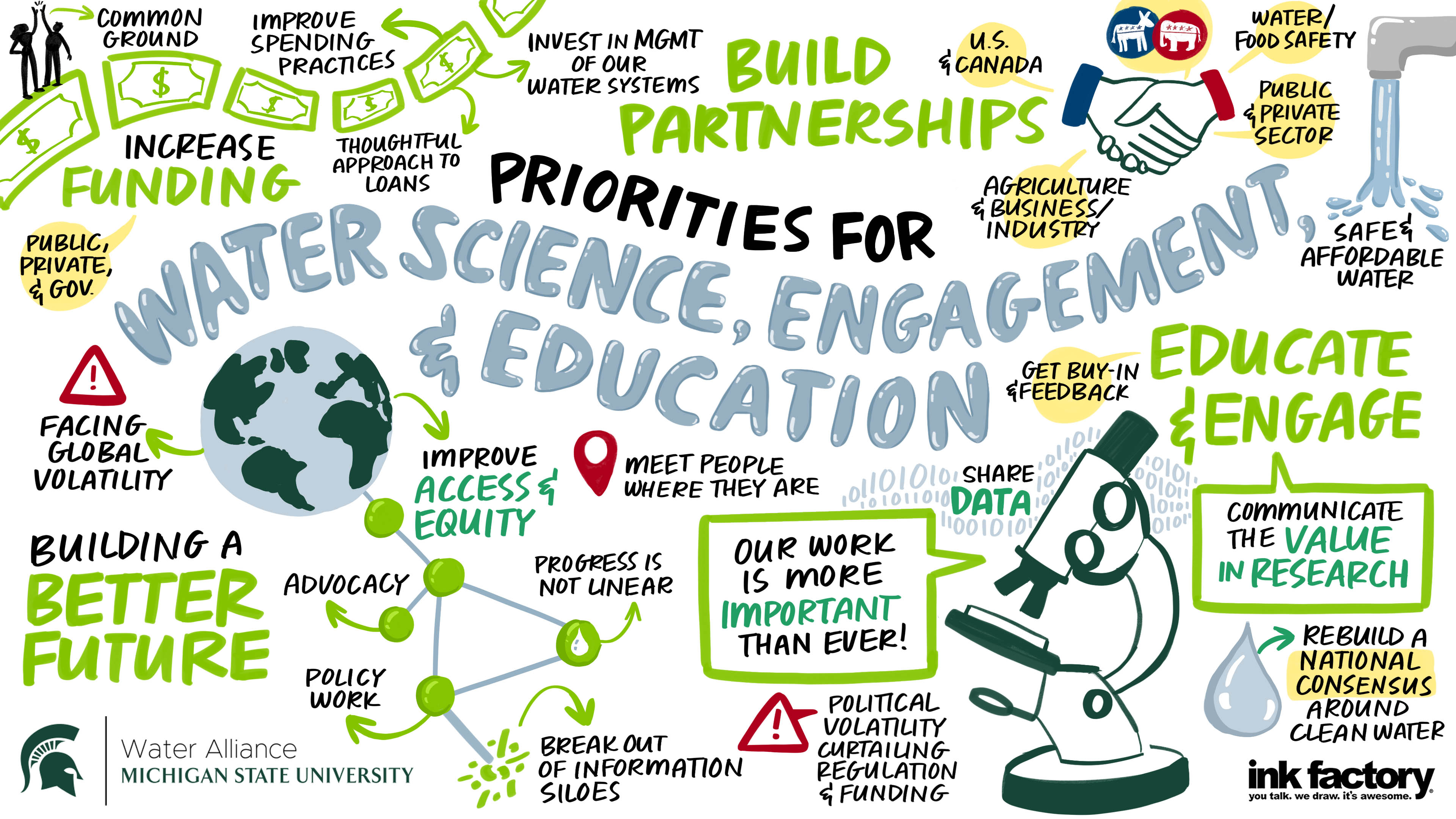
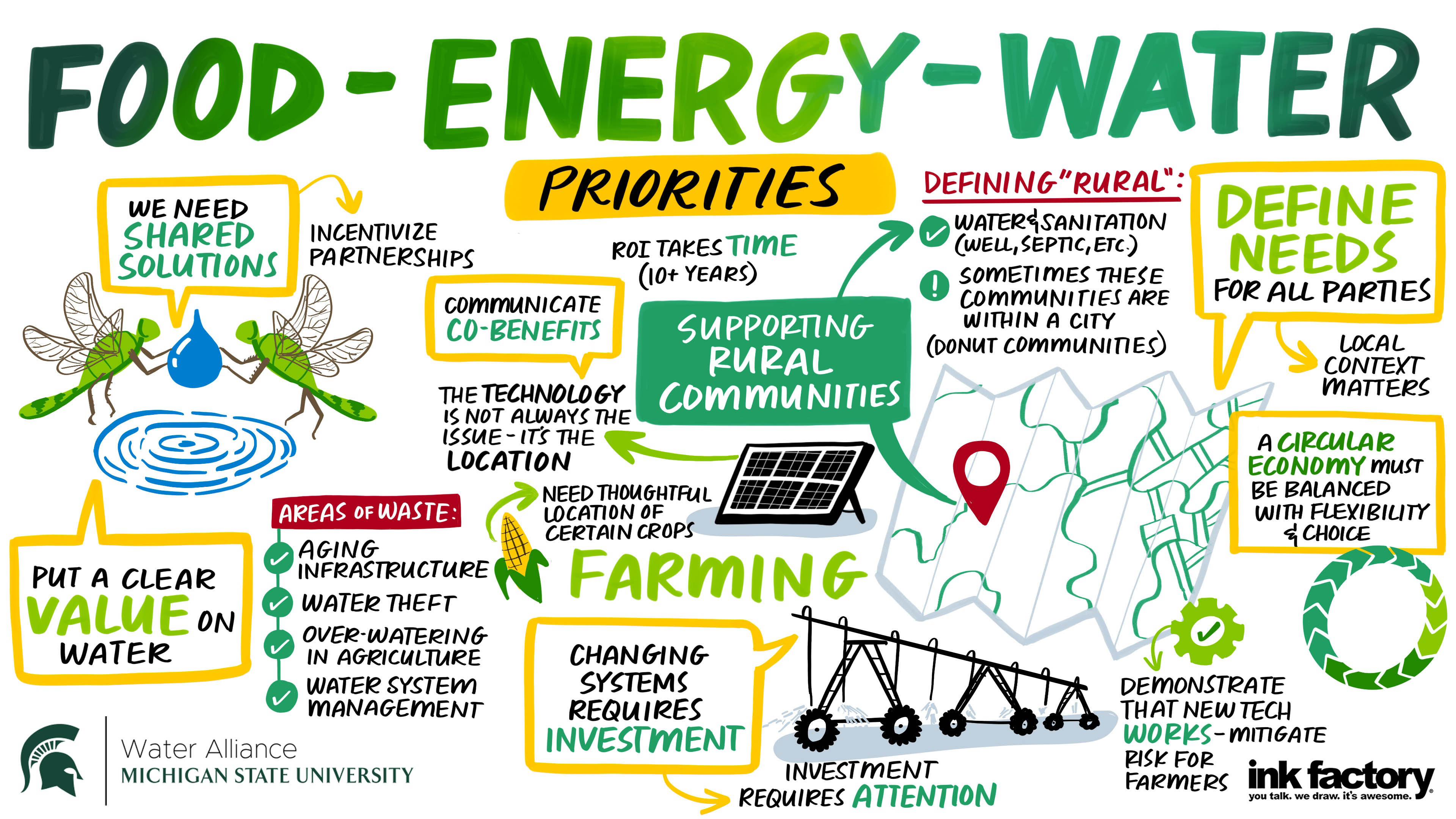
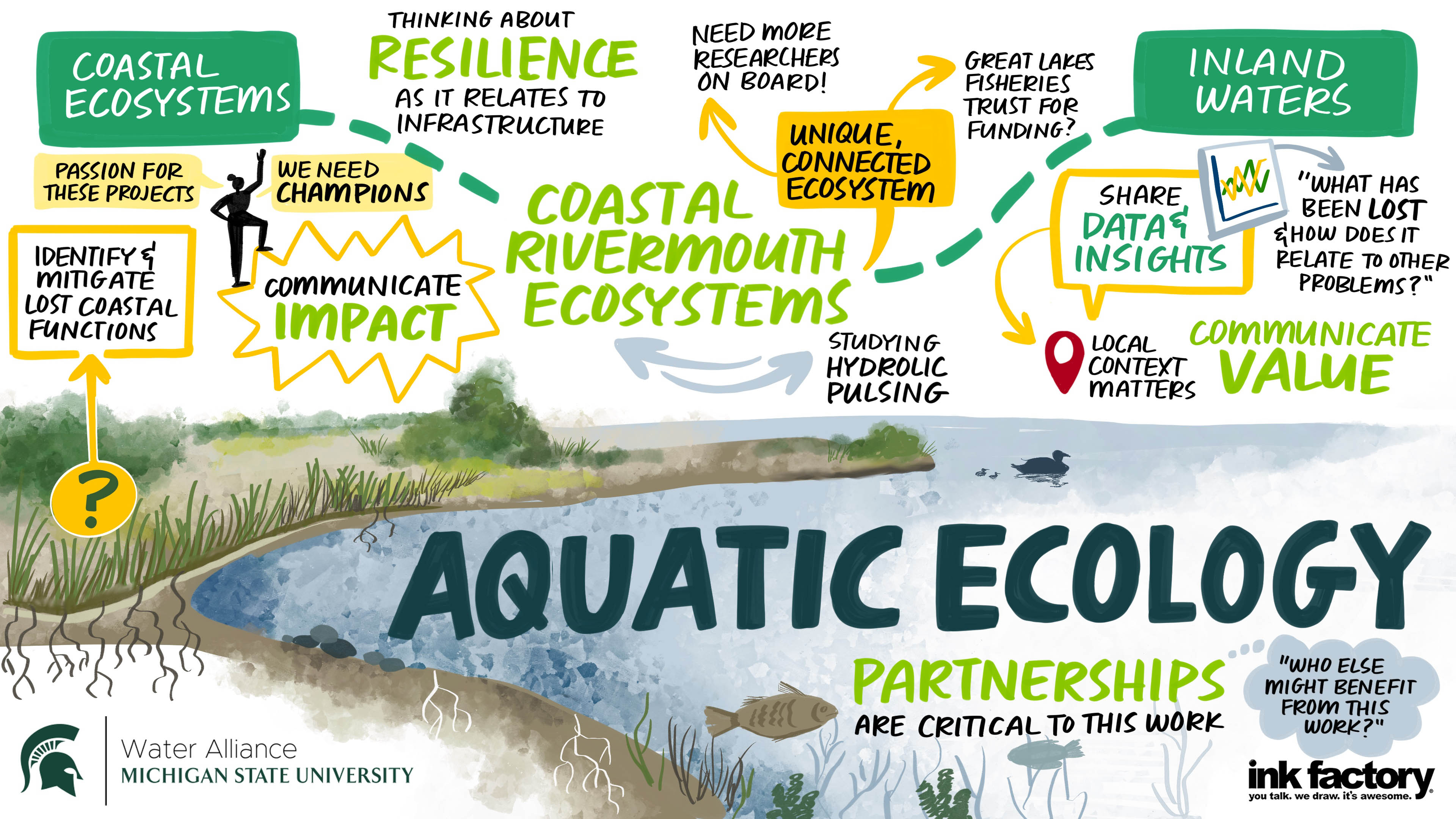
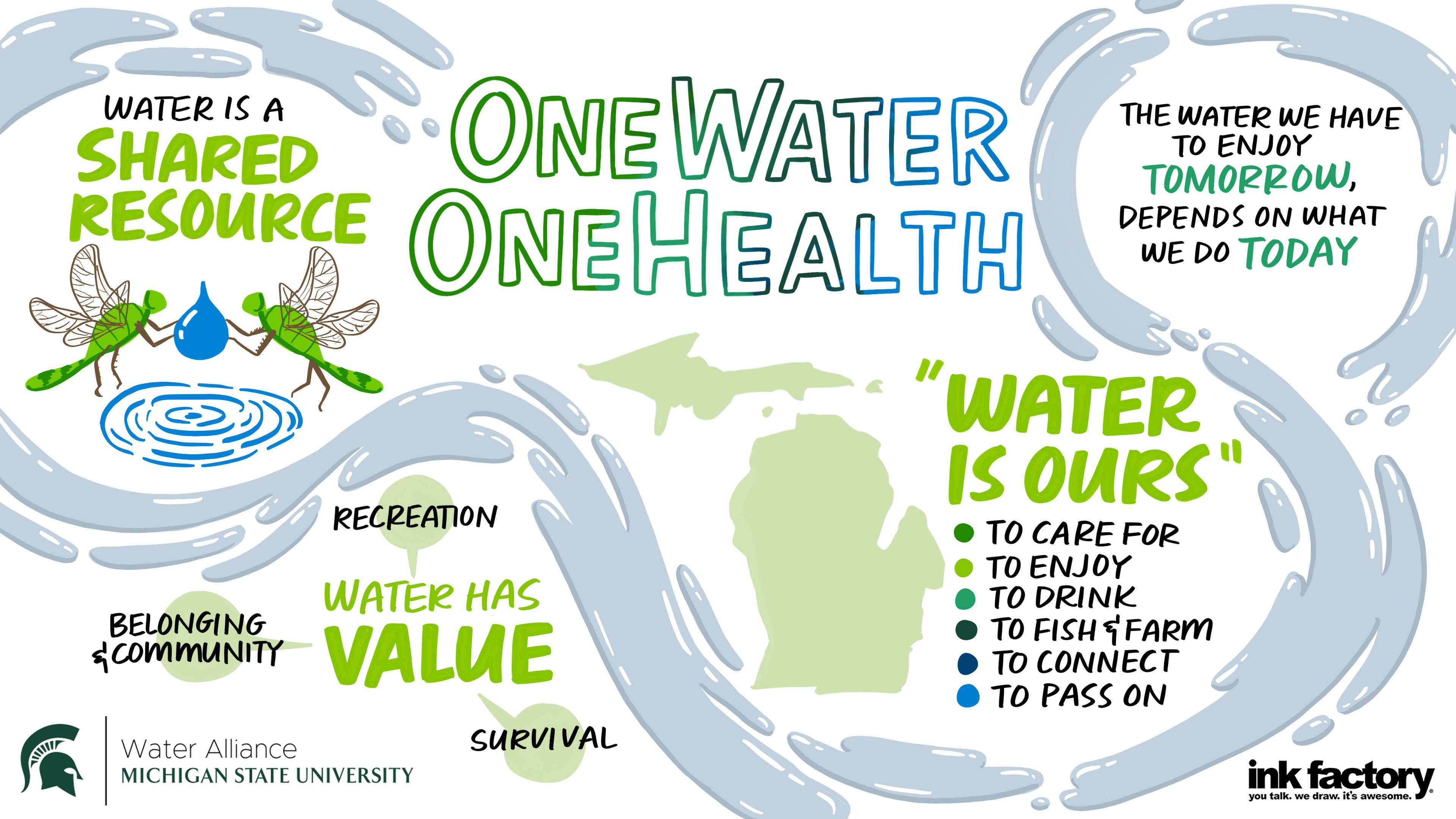

What’s Next?
Keep an eye out for more photos from the symposium, and upcoming opportunities for collaboration!
Story by Aja Witt
